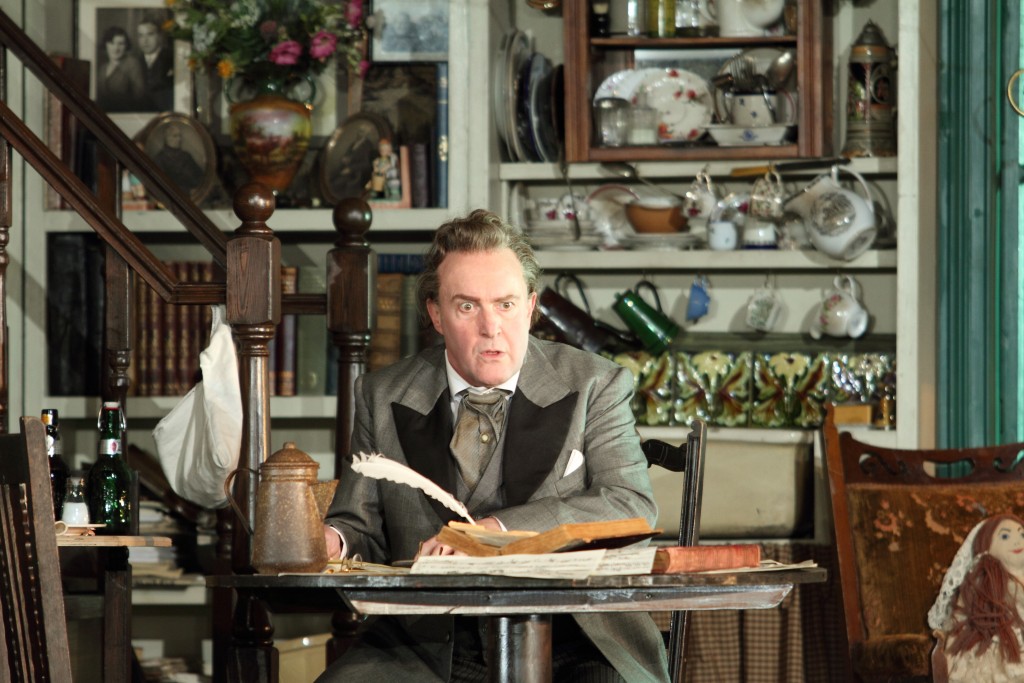Richard Wagner: A nürnbergi mesterdalnokok – Angol Nemzeti Opera (ENO), London, 2015. február 7. KŐRY ÁGNES írása
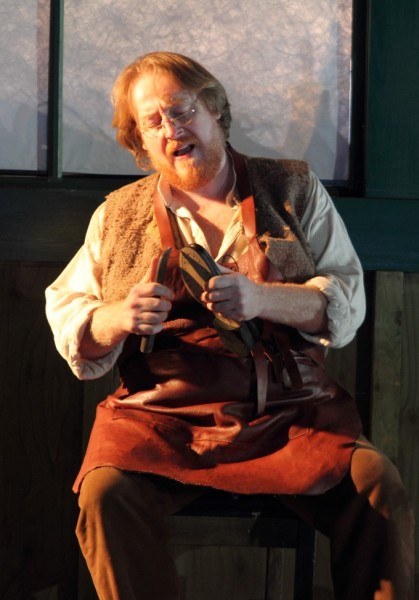
Váratlanul lenyűgöző Mesterdalnokok-előadással lepte meg az Angol Nemzeti Opera (ENO) a londoni közönséget. A rendező, Richard Jones a Walesi Nemzeti Opera (Welsh National Opera) társulatával mutatta be ezt a produkciót 2010 nyarán. Nem láttam a walesi előadást, így nem tudom, mennyivel javult vagy romlott a koncepció. Azt viszont tudom, hogy ezúttal ritka szép előadásban volt részünk!
A jelenlegi felújítás legmegdöbbentőbb része a szólóénekesek világklasszis színvonala volt annak ellenére, hogy legalább három szólista éppen ezen az estén debütált szerepében. Iain Paterson (Sachs) és Andrew Shore (Beckmesser) olyan zenei és színpadi teljesítményt nyújtott, amely általában csak a szerep sokszoros előadása után várható. Paterson nem vaskos Sachs; sokkal líraibb, mint sok korábbi nagy Sachs-alakítás. Bár hangja elvben basszbariton, Paterson inkább tűnik baritonnak, mint basszusnak – vagy a szokásosnál sebezhetőbbnek érzi Sachs alakját. Az biztos, hogy Paterson maximális érzékenységgel énekel és teljes drámai ábrázolást nyújt. Nem tudni, hogy ez a tolmácsolás Richard Jones vagy Paterson koncepcióját tükrözi-e inkább, de Sachs ezúttal legalább annyira kívülálló, mint amennyire elkötelezett és lojális mesterdalnok. Andrew Shore Beckmessere a szokásosnál kevésbé bolond. Shore már sok más operaszerepében bizonyította, hogy a diszkrét tragikomédia nagymestere; itt is jól adagolja Beckmesser alakjának szimpatikus, tragikus és komikus jellemvonásait. Kiváló énekesi teljesítménye pedig drámai alakításának természetes következménye.
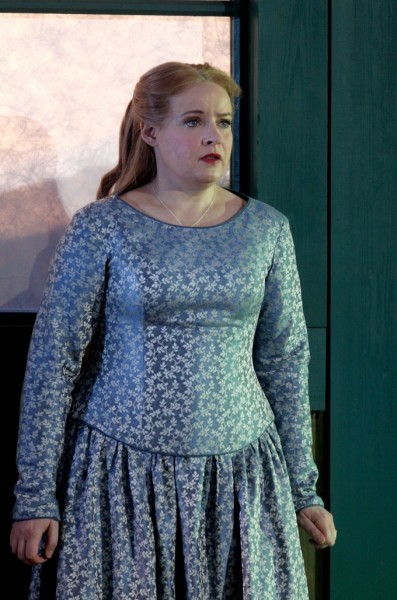
Nicky Spence szintén most debütált mint Dávid; mind ő, mind Gwyn Hughes Jones (Walther) biztonsággal és megejtő líraisággal tolmácsolta szólamát. Valószínűleg probléma nélkül szerepet is cserélhettek volna. A műsorfüzetből nem derül ki, hogy a többi szólista közül ki énekelte már szerepét előzőleg is – habár a kiváló Rachel Nicholls már játszotta Évát a Karlsruhei Badisches Staatstheaterben –, de valamennyien teljes azonosulással formálták karakterüket. James Creswell a lehető legnemesebb Pogner; Madeleine Shaw (Magdalene) erős, de ugyanakkor bájos támasza volt Évának (és Dávidnak). A harmadik felvonás kvintettje nem lehetett volna szebb, jobb és meghatóbb.
A már említett szólóénekesektől eltekintve sem volt gyenge szereplő a nagylétszámú énekesgárdában. Mindnyájan kiváló teljesítményt nyújtottak úgy egyénileg, mint az együttesekben. A karmester, Edward Gardner (az ENO főzeneigazgatója, aki az évad végén távozik posztjáról) jó tempókat választott, és nagyszerű teljesítményre serkentette a kórust és zenekart.
Az Angol Nemzeti Operában minden operát angolul énekelnek, így A nürnbergi mesterdalnokokat is. Frederick Jameson angol szövege kiváló: nem csak a lényeget fordítja, hanem Hans Sachshoz méltón poétikusan rímel.
A rendező, Richard Jones a cselekményt 1868-ra (tehát a Mesterdalnokok ősbemutatójának idejére) helyezte át. A nyitány alatt – és a felvonások közti szünetekben – a színpad felett egy nagy vásznat látunk, amelyre a díszlettervező, Paul Steinberg százhárom portrét helyezett. Valamennyien a német művészetek úttörői, kezdve a reneszánsztól egészen a 20. századig. Jelen van Billy Wilder, Marlene Dietrich és Karajan is, noha természetesen ők még nem éltek 1868-ban. Sajnálatos, hogy a portrékon ábrázolt személyek nincsenek megnevezve, habár a találgatás talán a produkció részét képezi. Az arcképek újra megjelennek a plakátokon, amelyeket kórustagok és a szólóénekesek tartanak a magasba az opera zárójelenetében. De ez alkalommal Hans Sachs portréja is megjelenik közöttük, habár korábban, a nagy vásznon nem látható. Talán arra utal mindez, hogy Wagner nélkül nem ismernénk a történelmi Hans Sachsot (1494-1576)?
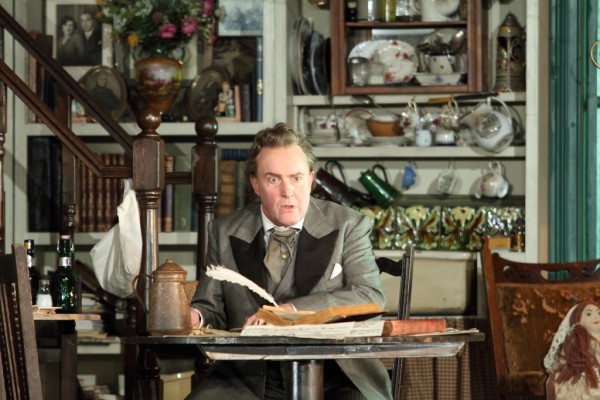
Richard Jones több jelenetben nyújt újító tolmácsolást. Például Walther beszámolóját a mesterdalnokokkal való első sikertelen találkozójáról ijesztő hallucinációként ábrázolja. A versenydal viszont ágyon fekve, pszichoanalízis keretében születik; Sachs úgy jegyzetel, mint aki az álmot próbálja értelmezni. Jones és koreográfusa, Lucy Burge bájos (és szemmel láthatóan többszólamú) ellentétet mutat a mesterdalnokok és a tanulók között az első felvonás fináléjában. Buki Shiff jelmezei és Mimi Jordan Sherin világítása méltón gazdagította a sok szép látni- és hallgatnivalót. Felejthetetlen előadást kaptunk.
Fotók: Catherine Ashmore / English National Opera
The Mastersingers of Nuremberg, English National Opera, 7th February 2015
by Agnes Kory
The revival of Richard Jones’s staging of The Mastersingers of Nuremberg for the Welsh National Opera in the summer of 2010 made an unexpectedly triumphant appearance at the English National Opera on 7th February 2015.
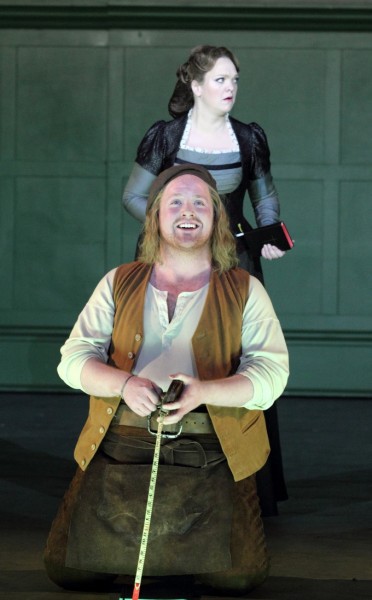
The most astonishing aspect of this first-night performance was the world-class standard of the principal singers, three of whom made their role debuts this evening. Iain Paterson (Sachs) and Andrew Shore (Beckmesser) delivered such assured musical and dramatic portrayals which would normally be expected only after long periods in such roles. Paterson is not a beefy Sachs; he is a lot more lyrical than many great Sachs performers in the past. Although he is described as a bass-baritone, perhaps Paterson is more a baritone than bass or perhaps he sees Sachs more vulnerable than some other interpreters. At any event, he sings his role with utmost sensitivity while delivering a full dramatic portrayal. Whether it is Richard Jones’s concept or Paterson’s, Sachs here is just as much an outsider as a committed and loyal mastersinger. On the other hand, Andrew Shore’s Beckmesser is less of a fool than customary. As he proved in great many of his operatic roles, Shore is a master of understated tragicomedy; he negotiates the sympathetic, tragic and comic aspects of Beckmesser’s character just right. Shore’s singing is a natural outcome of the character he inhabits.
Nicky Spence also made his role debut (as David); he and Gwyn Hughes Jones (Walter) were assured, lyrical and most probably would have been perfectly capable of swapping their roles. It is not clear from the programme notes how many of the other principals performed their roles previously – although the excellent Rachel Nicholls sang Eva for the Badisches Staatstheater, Karlsruhe) – but they all lived their parts on the stage. James Creswell was the noblest Pogner imaginable; Madeleine Shaw (Magdalene) was a strong but charming support to Eva (and David). The quintet (Act III) was delivered as beautifully as one could have wished for. But it is important to add that, apart from the principal singers discussed above, there was not a single weak link among the rest of the large cast. All were excellent individually and all excelled in ensemble work. With his well-chosen tempi, conductor (and outgoing ENO Music Director) Edward Gardner drew outstanding performances from chorus and orchestra; he was in full control throughout.
As all performances at the English National Opera, The Mastersingers too is sung in English. However, Frederick Jameson’s translation is not only literary but it suitably rhymes and thus corresponds with the Sachsian artistic input.
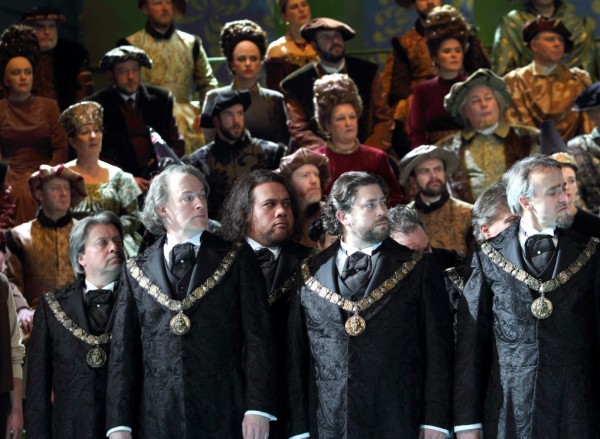
The staging is set in 1868 (the year of the opera’s first performance). Nevertheless, throughout the Overture, we see designer Paul Steinberg’s large front-cloth which displays faces of 103 ground-breaking German artists from the Renaissance period up to and including the 20th century. It is a shame that the names are not listed anywhere although perhaps the guessing element was intended as part of the production. The same faces appear on placards carried by chorus and principals in the finale. This time Hans Sachs’s portray is also displayed (while it does not appear on the front-cloth). Was this perhaps a message to say that without Wagner we would have not been aware of the real Hans Sachs (1494-1576)?
Richard Jones incorporates several innovative ingredients into his staging. For instance, Walther’s recollection of his failure at the first meeting with the mastersingers is presented as a scene of hallucination while the first appearance of his eventual Prize Song is presented on a Freudian couch with Sachs taking notes as if interpreting the dream. Jones and his choreographer Lucy Burge present a delightful (and visibly polyphonic) contrast between mastersingers and apprentices during the finale of Act I.
The costumes (Buki Shiff) and lighting (Mimi Jordan Sherin) added sumptuous richness to the feast of ears and eyes. This was a performance never to be forgotten.
Photos by Catherine Ashmore / English National Opera

